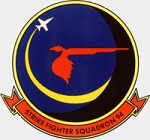Hobby Master HA3529 US Navy Boeing F/A-18C Hornet Strike Fighter - BuNo 164048, VFA-94 "Mighty Shrikes", Operation Iraqi Freedom, 2003 (1:72 Scale)
"Bigger, Higher, Faster, Farther."
- Thinking within the US Air Force during the late 1970s
 The F/A-18 Hornet is the true multi-role aircraft. It can vault from a carrier deck, bomb a target and stay to dogfight even the best enemy aircraft without missing a beat. It's the Navy's first modern-era jet intended for double duty against air- and ground-based adversaries. Armed to the hilt with Sparrow and Sidewinder air-to-air missiles, an internal cannon, and laser-guided bombs, this modern warbird was an outstanding performer in Operation Desert Storm. Strapped into a digital cockpit described as a cross between Star Wars and a video game, pilots of the F/A-18 Hornet take on the ultimate aviation job: blasting this single-seat, high-performance jet off the deck of a carrier, dropping bombs, and firing air-to-ground ordnance. Offering unmatched agility, the Hornet is the choice aircraft of the US Navy's elite Blue Angels aerobatic team.
The F/A-18 Hornet is the true multi-role aircraft. It can vault from a carrier deck, bomb a target and stay to dogfight even the best enemy aircraft without missing a beat. It's the Navy's first modern-era jet intended for double duty against air- and ground-based adversaries. Armed to the hilt with Sparrow and Sidewinder air-to-air missiles, an internal cannon, and laser-guided bombs, this modern warbird was an outstanding performer in Operation Desert Storm. Strapped into a digital cockpit described as a cross between Star Wars and a video game, pilots of the F/A-18 Hornet take on the ultimate aviation job: blasting this single-seat, high-performance jet off the deck of a carrier, dropping bombs, and firing air-to-ground ordnance. Offering unmatched agility, the Hornet is the choice aircraft of the US Navy's elite Blue Angels aerobatic team.
The F/A-18C is the single-seat variant and the F/A-18D is the two-seat variant. The D-model can be configured for training or as an all-weather strike craft. The "missionized" D model's rear seat is configured for a Marine Corps Naval Flight Officer who functions as a Weapons and Sensors Officer to assist in operating the weapons systems. The F/A-18D is primarily operated by the U.S. Marine Corps in the night attack and Forward Air Controller (Airborne) (FAC(A)) roles.
The F/A-18C and D models are the result of a block upgrade in 1987 incorporating upgraded radar, avionics, and the capacity to carry new missiles such as the AIM-120 AMRAAM air-to-air missile and AGM-65 Maverick and AGM-84 Harpoon air-to-surface missiles. Other upgrades include the Martin-Baker NACES (Navy Aircrew Common ejection seat), and a self-protection jammer. A synthetic aperture ground mapping radar enables the pilot to locate targets in poor visibility conditions. C and D models delivered since 1989 also have improved night attack abilities, consisting of the Hughes AN/AAR-50 thermal navigation pod, the Loral AN/AAS-38 NITE Hawk FLIR (forward looking infrared array) targeting pod, night vision goggles, and two full-color (formerly monochrome) multi-function display (MFDs) and a color moving map.
Pictured here is a gorgeous 1:72 scale diecast replica of a US Navy F/A-18C Hornet Strike Fighter that was attached to VFA-94 "Mighty Shrikes", then participating in Operation Iraqi Freedom during 2003.
Sold Out!
Dimensions:
Wingspan: 7-1/2-inches
Length: 9-inches
Release Date: February 2017
 Historical Account: "Mighty Shrikes" - Strike Fighter Squadron 94 (VFA-94), also known as the "Mighty Shrikes", are a United States Navy fighter squadron stationed at Naval Air Station Lemoore. They are an operational fleet squadron currently flying the F/A-18F Super Hornet. They are attached to Carrier Air Wing 17 (CVW 17) and based at NAS Lemoore, California. Their tail code is NA and their radio call sign is Hobo.
Historical Account: "Mighty Shrikes" - Strike Fighter Squadron 94 (VFA-94), also known as the "Mighty Shrikes", are a United States Navy fighter squadron stationed at Naval Air Station Lemoore. They are an operational fleet squadron currently flying the F/A-18F Super Hornet. They are attached to Carrier Air Wing 17 (CVW 17) and based at NAS Lemoore, California. Their tail code is NA and their radio call sign is Hobo.
In January 2012, after returning from UDP duties in Japan, the squadron returned to NAS Lemoore, but apparently was not assigned to one of the West Coast air wings until around August 2012, as it temporarily took sister squadron VFA-25's place within CVW-17. VFA-25 was returned to its former slot within CVW-17, thus replacing VFA-94.
On September 12th, 2014, two F/A-18Cs, one from VFA-94 and the other from VFA-113 collided and crashed approximately 250 nautical miles (460 km; 290 mi) west of Wake Island. One aviator was recovered in fair condition and received medical treatment aboard the Carl Vinson. Search-and-rescue (SAR) operations continued for the other aviator. The Carl Vinson was participating in Exercise Valiant Shield 2014 at the time of the mid-air collision. The search was called off on September 14th, 2014, and the missing aviator was declared missing and presumed dead, with the crash incident under investigation.
The Mighty Shrikes began their transition from the F/A-18C Hornet to the F/A-18F Super Hornet in September 2015, completing the transition in March 2016.









